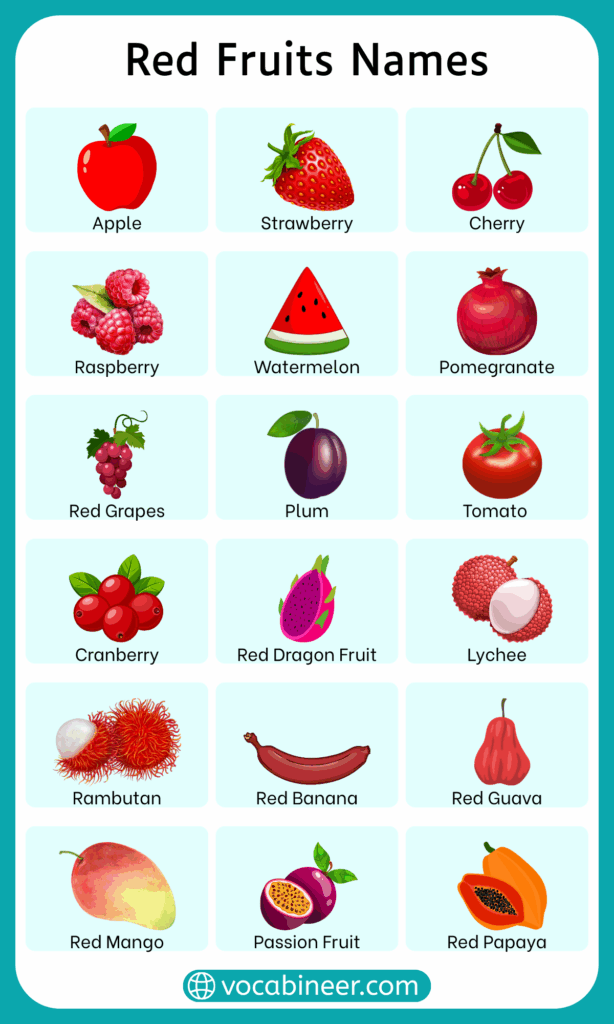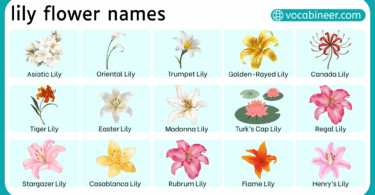Red fruits are widely known for their bright colors and natural sweetness. They include common varieties like apples and cherries as well as tropical options such as lychee and rambutan. Learning their names helps recognize different fruits quickly and connect them with their natural appearance. This post gives a complete set of red fruits names with pictures so readers can understand them easily. By the end, you’ll know how these names are used when talking about food, markets, and everyday learning.
In This Page
Common Red Fruits People Know
These are the fruits people see and eat the most often. They’re grown in many countries and are part of daily meals, snacks, and drinks. Below is a list of well-known red fruits with simple descriptions.
- Apple varieties with red skin
Red apples: Types like Red Delicious, Fuji, Gala, Jonathon, and Pink Lady are crisp and juicy, eaten raw or baked. - Strawberry
Strawberry: Bright red fruit with tiny seeds on the surface. Sweet, juicy, and used in cakes, jams, and milkshakes. - Cherries
Cherry: Small, round, and sweet or tart. They’re popular in desserts, pies, and preserves. - Raspberry
Raspberry: Soft clusters of drupelets, sweet with a tangy edge. Common in smoothies, sauces, and jams. - Watermelon
Watermelon: Large fruit with green skin and red flesh. Refreshing and hydrating, mostly eaten fresh. - Tomato
Tomato: Botanically a fruit with red skin and pulp. Used in soups, sauces, salads, and juices. - Red pear
Red pear: Smooth red skin with juicy, sweet flesh. Best enjoyed fresh or in salads. - Red fig
Red fig: Red to purple skin with sweet, seeded pulp inside. Often dried or eaten raw.

Tropical and Exotic Red Fruits
Tropical and exotic fruits grow best in warm climates and often surprise with unusual textures and tastes. Many of them are eaten fresh, while others are juiced or used in regional dishes. Below is a list of such fruits.
- Pomegranate
Pomegranate: Thick outer shell containing red juicy seeds. Seeds are eaten fresh or juiced. - Lychee
Lychee: Small fruit with bumpy red skin and soft, sweet white flesh. - Rambutan
Rambutan: Hair-covered red skin with juicy white pulp inside. - Dragon fruit with red skin
Red dragon fruit: Red skin with green scales. Flesh may be white or red with black seeds. - Red banana
Red banana: Shorter banana with reddish skin and creamy pulp. - Persimmon
Persimmon: Red-orange smooth skin. Flesh is sweet and soft when ripe. - Mangosteen
Mangosteen: Known as “queen of fruits.” Some types have reddish skin and juicy pulp. - Sapodilla
Sapodilla: Brownish-red skin with reddish-brown flesh. Sweet with caramel-like flavor.
Berries in Red Color
Berries are small, bright fruits that often have sharp or tangy flavors. They’re used fresh, cooked into jams, dried for snacks, or added to juices. Below is a list of red berries that are commonly recognized.
- Cranberry
Cranberry: Small and sour, mostly juiced, cooked, or dried. - Red currant
Red currant: Shiny clusters, sharp in taste, used in jellies. - Goji berry
Goji berry: Long red berries, often dried for teas and soups. - Acerola cherry
Acerola cherry: Barbados cherry, rich in vitamin C. - Red mulberry
Red mulberry: Juicy berries from mulberry trees. Sweet with mild tartness. - Strawberry tree fruit
Strawberry tree fruit: Round red berries with mild sweetness. - Cloudberry
Cloudberry: Red-orange fruit that turns golden when ripe. Tart flavor, often preserved.
Stone Fruits That Turn Red
Stone fruits have a seed or “stone” inside, covered by juicy edible flesh. Many of them ripen with red shades on their skins, making them attractive and tasty. Below is a list of stone fruits that turn red.
- Plum
Plum: Reddish to purple skin, sweet or tangy pulp. - Nectarine
Nectarine: Smooth-skinned fruit similar to peach. Juicy and sweet. - Peach varieties
Peach: Yellow-red fuzzy skin, fragrant and juicy. - Red apricot
Red apricot: Reddish skin, tart but sweet inside. - Cherry plum
Cherry plum: Small, tart fruit with red skin. - Damson plum
Damson plum: Oval fruit with dark red-purple skin, tangy taste.
Grapes and Vines
Grapes have been cultivated for centuries and are enjoyed worldwide. Red grapes and their varieties are eaten fresh, dried into raisins, or processed into juice and wine. Below is a list of popular red grapes.
- Red grape clusters
Red grapes: Juicy clusters eaten raw, dried as raisins, or juiced. - Red wine grapes
Wine grapes: Thick-skinned grapes for red wine production. - Concord grapes
Concord grapes: Deep red to purple grapes for juice or jelly.
Citrus and Related Fruits
Citrus fruits are usually orange or yellow, but some develop red shades in their flesh or skin. They are juicy, refreshing, and rich in flavor. Below is a list of red citrus fruits.
- Blood orange
Blood orange: Red pulp with a sweet raspberry-like flavor. - Red grapefruit
Red grapefruit: Large red-fleshed fruit, tangy and juicy. - Red lime hybrids
Red lime: Rare citrus hybrid with reddish pulp. - Red tangerine
Red tangerine: Also called red mandarin, juicy and sweet.
Melons and Gourds with Red Flesh
Melons and gourds are large fruits mostly eaten in slices during warm weather. Some varieties have red or reddish flesh that makes them stand out. Below is a list of such fruits.
- Red watermelon
Watermelon: Sweet red flesh eaten raw or juiced. - Red-fleshed papaya
Papaya: Red-orange flesh, soft and sweet. - Red-fleshed cantaloupe
Cantaloupe: Hybrid type with red flesh, fragrant and juicy. - Red honeydew
Honeydew melon: Hybrid melon with reddish pulp, refreshing and sweet.
Regional and Rare Red Fruits
Some fruits are not grown everywhere but are well known in certain regions. They often hold traditional value and are used in local dishes or remedies. Below is a list of regional and rare red fruits.
- Rose hip
Rose hip: Small red fruit of rose plants, used in teas. - Red guava
Red guava: Green outside with pink-red flesh. Sweet and fragrant. - Red passion fruit
Passion fruit: Red-skinned fruit with tangy pulp and seeds. - Surinam cherry
Surinam cherry: Ribbed red fruit, tart to sweet taste. - Bayberry
Bayberry: Asian red fruit, juicy and sweet-tart. - Hawthorn fruit
Hawthorn fruit: Tart fruit, often made into candies. - Prickly pear fruit
Prickly pear: Cactus fruit with red pulp, sweet and tangy.
Conclusion
Red fruits come in many shapes, tastes, and textures, from apples to pomegranates and from small berries to large melons. Learning these red fruits names helps when reading recipes, shopping in markets, or talking about food in English. With pictures, they become even easier to remember and recognize.
FAQs about 50 Red Fruits Names
Red fruits include berries such as strawberries and cranberries, common ones like apples and cherries, tropical fruits such as pomegranates and lychees, and even citrus like blood oranges.
The most familiar red fruit worldwide is the red apple. Other very common ones are strawberries, cherries, and watermelons that people eat almost daily.
The red color in fruits comes from natural pigments called anthocyanins and carotenoids. These give the fruits their bright shades and attract people and animals.
Red fruits are often rich in vitamins A and C, fiber, and antioxidants. They’re a healthy choice and add variety to everyday diets.
There are around 50 widely recognized red fruits, including common, exotic, and regional types. Lists usually include apples, berries, grapes, citrus, melons, and rare tropical fruits.
Read More




